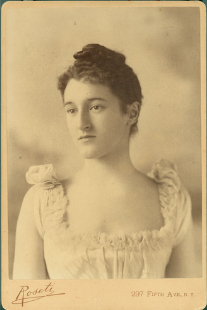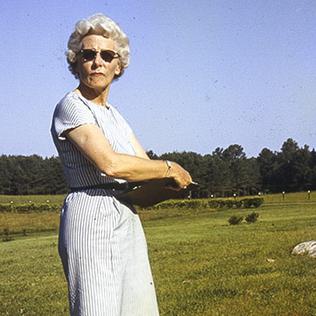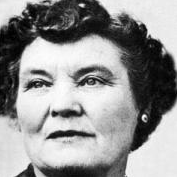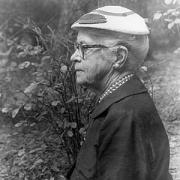
Beatrix Cadwalader Farrand was an American landscape gardener and landscape architect. Her career included commissions to design about 110 gardens for private residences, estates and country homes, public parks, botanic gardens, college campuses, and the White House. Only a few of her major works survive: Dumbarton Oaks in Washington, D.C., the Abby Aldrich Rockefeller Garden on Mount Desert, Maine, the restored Farm House Garden in Bar Harbor, the Peggy Rockefeller Rose Garden at the New York Botanical Garden, and elements of the campuses of Princeton, Yale, and Occidental.

Landscape architecture is the design of outdoor areas, landmarks, and structures to achieve environmental, social-behavioural, or aesthetic outcomes. It involves the systematic design and general engineering of various structures for construction and human use, investigation of existing social, ecological, and soil conditions and processes in the landscape, and the design of other interventions that will produce desired outcomes.

Groton is a town in northwestern Middlesex County, Massachusetts, United States, within the Greater Boston metropolitan area. The population was 11,315 at the 2020 census. It is home to two prep schools: Lawrence Academy at Groton, founded in 1792 and the third-oldest private school in Massachusetts; and Groton School, founded in 1884.

Landscape design is an independent profession and a design and art tradition, practiced by landscape designers, combining nature and culture. In contemporary practice, landscape design bridges the space between landscape architecture and garden design.

John Claudius Loudon was a Scottish botanist, garden designer and author. He was the first to use the term arboretum in writing to refer to a garden of plants, especially trees, collected for the purpose of scientific study. He was married to Jane Webb, a fellow horticulturalist, and author of science-fiction, fantasy, horror, and gothic stories.

The Arnold Arboretum of Harvard University is a botanical research institution and free public park, located in the Jamaica Plain and Roslindale neighborhoods of Boston, Massachusetts. Established in 1872, it is the oldest public arboretum in North America. The landscape was designed by Charles Sprague Sargent and Frederick Law Olmsted and is the second largest "link" in the Emerald Necklace. The Arnold Arboretum's collection of temperate trees, shrubs, and vines has a particular emphasis on the plants of the eastern United States and eastern Asia, where arboretum staff and colleagues are actively sourcing new material on plant collecting expeditions. The arboretum supports research in its landscape and in its Weld Hill Research Building.

Guy Lowell, was an American architect and landscape architect.
Guy Sternberg is the owner and operator of Starhill Forest Arboretum in Petersburg, Illinois. He is an arborist, author of books on oaks and is a founding member of the International Oak Society, tree consultant, and lecturer.

Ellen Biddle Shipman was an American landscape architect known for her formal gardens and lush planting style. Along with Beatrix Farrand and Marian Cruger Coffin, she dictated the style of the time and strongly influenced landscape design as a member of the first generation to break into the largely male occupation.

Mary Rutherfurd Jay (1872–1953) was one of America's earliest landscape architects and an advocate of horticultural education and careers for women. The great-great granddaughter of American Founding Father John Jay, she grew up in Rye, New York surrounded by the gardens of her ancestral homestead at the Jay Estate in Westchester County overlooking Long Island Sound. Her education was fostered by travel abroad with her mother and domestically through classes in design and horticulture taken at the Massachusetts Institute of Technology (MIT) and the Bussey Institute in Forest Hills, Massachusetts.

The Cambridge School of Architecture and Landscape Architecture—previously known as the Cambridge School of Architectural and Landscape Design for Women and then as Cambridge School of Domestic and Landscape Architecture for Women—was an educational institution for women that existed from 1915 to 1942. It was the first school to offer women graduate training in the professions of architecture and landscape architecture under a single faculty. It was affiliated originally with Harvard University and later with Smith College.

The Pennsylvania School of Horticulture for Women was one of the first horticultural schools to be established by and for women in the United States, opening on February 10, 1911. As the second institution to provide women with a practical education in horticulture and landscape architecture, it made possible their entry into a professional field. Although some men were employed in faculty positions, the school's leadership was intentionally female. As of 1919, the board of trustees consisted of twenty-five prominent women citizens. All but the last director of the school were women.

Edith Harrison Henderson (1911–2005) was an American landscape architect who practiced largely in the American South. She wrote a column for the Atlanta Journal Constitution and was the first woman to be elected an officer of the American Society of Landscape Architects.

Elizabeth Greenleaf Pattee (1893–1991) was an American architect, landscape architect, and architecture professor in the Northeast whose career spanned a half century.

Nellie Beatrice Osborn Allen (1874–1961) was an American landscape architect. She is known for her knot gardens.

Louisa Boyd Yeomans King was an American gardener and author who became a leading advocate of gardening and horticulture, especially in connection with the garden club movement. She wrote on horticultural topics as Mrs. Francis King.
Robert Swan Sturtevant was an American landscape architect and iris breeder. He taught for many years at the Lowthorpe School of Landscape Architecture, and he helped to found the American Iris Society.

Elsa Rehmann was an American landscape architect best known for her pioneering ecological approach to garden design. She and Edith A. Roberts promoted seeking inspiration in plant communities, which Rehmann considered to be the basis for design criteria and translated them into artistic composition.
Elizabeth Blodget Lord (1887–1974) was a founding partner of Lord & Schryver, the first female owned and operated landscape architecture firm in the Pacific Northwest from 1929-1969.
Edith Eleanor Schryver (1901–1984) was a founding partner of Lord & Schryver, the first female owned and operated landscape architecture firm in the Pacific Northwest from 1929 to 1969.


















